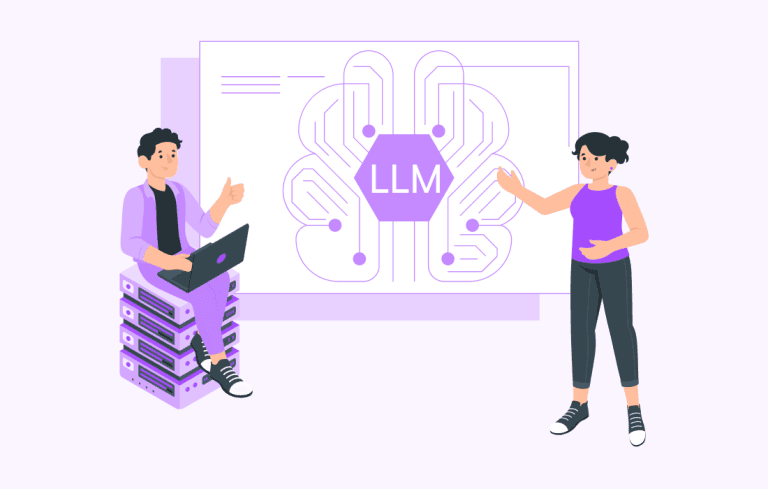Self-Hosted LLM: How to Run and Train Models Locally
Self-hosted LLMs let you run and fine-tune large language models on your own hardware, giving you more control, lower costs, and stronger data security. This guide explains what they are, why they matter in 2026, the resources required, and how to deploy and optimize them locally.

See, it’s all good to run large language models on cloud APIs. But things go south when you have to pay a hefty amount of token fees.
For teams that want to test things out, that was fine. But as you want to scale, costs multiply.
Add to that the compliance risks of sending sensitive data to external servers and the growing demand for domain-specific AI, and suddenly, self-hosting an LLM isn’t just an option – it’s a competitive advantage.
This guide walks you through what self-hosted LLMs are, why they matter now, and how to run and optimize them locally (without needing enterprise-level infrastructure).
Table of Contents
What Is a Self-Hosted LLM?
A self-hosted large language model that you will run these AI models on your own hardware instead of using a cloud provider’s API.
With self-hosted LLMs, you will have flexibility for:
- Data privacy → Your inputs never leave your environment.
- Cost efficiency → After initial setup, you avoid recurring per-token fees.
- Customization → You can fine-tune the model on proprietary data.
- Offline capability → Useful for air-gapped or regulated environments.
Due to these benefits, the demand for custom large language model solutions has increased.
Some of the most popular open-source LLMs today include:
- LLaMA 3 (Meta) → High accuracy, strong open-source ecosystem.
- Mistral → Lightweight, fast, great for edge and consumer GPUs.
- Falcon → Strong performer for text generation and summarization.
- GPT-J / GPT-NeoX → Earlier open-source projects, still useful for certain cases.
Why Is There a Need to Self-Host an LLM in 2026?

What initially appeared to be a convenience (using LLMs via API) has evolved into a cost and control issue.
Here’s why more teams are turning to self-hosted LLMs:
-
Rising Costs of Cloud AI
Cloud APIs charge per token, and those micro-costs add up fast once models move from testing to production. Many teams now face monthly bills in the tens of thousands. A self-hosted setup requires upfront hardware, but the investment often breaks even within months compared to ongoing API fees.
-
Data Privacy and Compliance
When you use a cloud AI service, your data has to leave your system and pass through someone else’s servers. For companies handling sensitive information — like patient records, financial transactions, or legal files — that’s a serious risk.
-
Customization and Domain-Specific Training
Cloud models are general-purpose by design. They rarely perform at their best without fine-tuning, which usually means sending your proprietary data back to the provider. Self-hosted models let you adapt them with domain-specific datasets while keeping that data private.
-
Reliability and Independence
API rate limits, downtime, or sudden price changes are business risks. When you self-host, you decide your availability, upgrade path, and scaling strategy — without being tied to a vendor’s roadmap.
Self-Hosting vs Cloud: Which One Fits Your Use Case?
Now, you must be thinking, what’s the actual difference between self-hosting and cloud-based LLMs? Here’s a simple comparison:
|
Factor |
Cloud AI (OpenAI, Anthropic, etc.) |
Self-Hosted LLM |
| Setup | Zero setup, ready instantly | Hardware + configuration required |
| Cost | Ongoing per-token or subscription fees | One-time hardware + electricity |
| Data Security | Data leaves your environment | Data stays fully in-house |
| Scalability | Instantly scalable with a provider | Limited by your hardware |
| Flexibility | Restricted to the provider’s options | Full customization, fine-tuning possible |
| Dependence | Tied to provider’s pricing & uptime | Independent, you control everything |
And these days, there are good custom LLM Development Company like SolGuruz that will help you host your own LLM super fast.
Resources You Need to Run an LLM Locally
Running an LLM on your own machines doesn’t always mean you need a data center. The exact setup depends on the size of the model and what you want to do with it.
1) Hardware
At the core, you’ll need a strong GPU. Consumer GPUs like the NVIDIA RTX 4090 can handle smaller models (7B–13B parameters) well. Whereas enterprise GPUs like the A100 or H100 are designed for very large models (70B+).
2) Software
Most self-hosted LLMs run on top of open-source frameworks like PyTorch or TensorFlow. Usually, Hugging Face Transformers is the go-to library for downloading and using models. And for serving and running them efficiently, tools like vLLM, Text Generation WebUI, LM Studio, or Ollama are widely used.
3) Operating System
Linux is the most common choice, mainly because of better GPU driver support and stability. Windows with WSL2 can work too, but often requires extra configuration.
4) Budgeting
- A consumer-grade setup (RTX 4090, 128GB RAM) can be built for $4K–6K.
- Renting enterprise GPUs in the cloud can cost $3–4 per hour, which adds up quickly.
- For long-term use, owning hardware often pays for itself within a year.
How to Deploy an LLM Locally (Step-by-Step)

If you ask me, I think getting an LLM running on your own machine is much easier now than it was a year ago. Most of the complexity has been packaged into tools with simple interfaces. Here’s the typical flow:
1. Get Your Environment Ready
Make sure your machine has the basics installed — the right GPU drivers and either Linux or Windows with WSL2. This ensures your hardware can actually run the model.
2. Download a Model
Head over to open-source hubs like Hugging Face or use tools like Ollama or LM Studio to pull down a pre-trained model. Smaller models (7B–13B parameters) are a good place to start since they’re easier to run on consumer hardware.
3. Run the Model
You can interact with the model using simple interfaces. For example:
- Ollama lets you run models from the command line with one command.
- LM Studio provides a user-friendly desktop app.
- Text Generation WebUI offers a web interface for chatting with your model.
4. (Optional) Fine-Tune It
If you need the model to understand your company’s data or tone, you can fine-tune it. Tools like LoRA or QLoRA make this possible even on consumer-grade hardware.
5. Test and Iterate
Start small. Ask it to summarize a document or answer domain-specific questions. Measure response times and accuracy, then adjust settings like quantization (lighter model formats) to improve performance.
Optimizing Performance Without Enterprise GPUs
Not every team has access to $30K+ enterprise GPUs, and the good news is you don’t need them to run useful LLMs. With a few optimizations, you can get strong performance even on consumer hardware.
1. Use Smaller or Lighter Models
Bigger isn’t always better. A 7B or 13B parameter model can handle many business tasks (summarization, Q&A, chatbots) without requiring massive GPUs. You need to choose the smallest model that meets your needs.
2. Apply Quantization
Quantization is a method of shrinking the model so it uses less memory while still giving good results. In practice, this means a large model that normally wouldn’t fit on your GPU can run smoothly — though sometimes with a slight trade-off in accuracy.
3. Optimize Memory and Processing
Adjusting batch sizes (how much data the model processes at once) can prevent memory crashes. Fast SSDs also help reduce lag when the GPU is under heavy load.
4. Run Across Multiple GPUs (If Available)
If you have more than one GPU, you can split the model across them. This will help you run larger models.
5. Benchmark and Adjust
Every setup is different, so test your model’s speed and accuracy. Simple benchmarks (like how many tokens it generates per second) help you see whether optimizations are working.
Common Pitfalls and How to Avoid Them

Not everything will go as it’s planned. I’ve talked with many businesses that have run leaf-hosted LLMs, and here are some of the common mistakes they usually make:
-
Running Out of Memory (VRAM Errors)
Large models can exceed your GPU’s limits and crash. Start with smaller models, use quantized versions (e.g., 4-bit), and lower batch size or context length. If you still hit limits, move some layers to the CPU or use multiple GPUs.
-
Slow Responses Despite Strong Hardware
Bottlenecks often come from the wrong drivers, outdated CUDA/toolkit versions, or a slow SSD. Match driver + toolkit versions to your software, turn on GPU acceleration in your runner (e.g., enable tensor cores/FP16), and put model files on a fast NVMe SSD.
-
Poor Output Quality After Fine-Tuning
Overfitting to a small dataset can make the model forget general knowledge. Use parameter-efficient tuning (LoRA/QLoRA), mix in a slice of general data, and validate on real tasks before pushing to production.
-
Unstable Environments
Random package updates can break your setup. Pin versions in a requirements.txt or use containers, keep a clean “prod” environment, and test upgrades in a sandbox first.
-
Hidden Licensing and Usage Risks
Some “open” models restrict commercial use or require attribution. Read the model’s license and any dataset terms before deployment to avoid compliance problems.
-
Security Gaps on “Local” Setups
Local doesn’t automatically mean safe. Limit network access to your model server, rotate API keys, apply OS patches, and audit logs. If you’re handling sensitive data, then make sure that you consider an isolated (air-gapped) machine.
Conclusion: Should You Self-Host an LLM?
Self-hosting an LLM isn’t about replacing cloud AI entirely – it’s about knowing when control matters more than convenience. In 2026, that control can mean cutting runaway API costs, keeping sensitive data in-house, and tailoring models to fit your exact use case.
Yes, it takes some setup. But with today’s open-source models and tools, running an LLM locally is pretty easy.
Also, if your business relies heavily on AI, it’s better to opt for self-hosting. You can start small, optimize as you go, and scale only when the benefits are.
If you need help, then you can reach out to companies that provide LLM development services. They are expert in this kind of work.
FAQs
1. What is the Best way to self-host an open-source LLM for enterprise use?
The most effective method to self-host an open source LLM model is to use containerised infrastructure such as Docker or Kubernetes. It allows orchestration and automated resource management. Integrating it with GPU orchestration tools like NVIDIA GPU operator for better performance and cost effectiveness. You can also prefer to use high-performance inference frameworks (LLM, TGI, Deepspeed) to obtain low latency.
2. How much cheaper is self-hosting compared to using cloud APIs?
It depends on your usage. For teams with light or occasional workloads, cloud may be more cost-effective. But if you’re processing large volumes daily, cloud API costs often climb into tens of thousands per month. A one-time investment in hardware usually pays for itself within months.
3. Can I fine-tune a self-hosted LLM with my company’s data?
Yes. Self-hosting gives you the freedom to fine-tune models with proprietary datasets without sending them to a third-party provider. This is a major advantage for teams in finance, healthcare, legal, or other data-sensitive fields.
4. What are the Best practices for self-hosting open-source LLM enterprise USA?
The best way for a self-hosting open source LLM enterprise in the USA is to properly focus on using data privacy and security by hosting models in private infrastructure or secure cloud environments, enforcing RBAC/IAM, encryption, and audit logging to meet compliance standards such as HIPAA, GDPR, and CCPA. For reliable production serving, leverage optimised inference frameworks like vLLM and Hugging Face TGI.
5. How to train your own LLM locally?
You need to start by defining your goal and picking a base model suited to your hardware. Let's say LLaMA 2–7B for mid-range GPUs. Then, prepare a domain-specific dataset and set up your environment. Use LoRA or QLoRA for efficient fine-tuning. Then all you need to do is optimize and deploy your model.
6. How to use large language models (LLM) in your own domains?
To use large language models (LLMs) properly in your own domains, choose a foundational model and adapt it by fine-tuning with domain-specific data or by prompt engineering to meet your use case. Further, for deeper alignment, use domain adaptation techniques such as continued pre-training, low-rank adapters (LoRA), and more.
7. How to choose a host for finetuned open-source language models?
When selecting a host for finetuned open-source language models, ensure properly configured with privacy and compliance needs. On-premise or private clouds are best for sensitive information. Match your hardware and budget requirements with available resources, from local servers for small models to cloud GPUs for high performance.
8. Do I really need expensive GPUs to run an LLM locally?
Not necessarily. Smaller models can run well on high-end consumer GPUs. With techniques like quantization, you can squeeze even large models into modest setups. Enterprise GPUs are only needed for very large-scale workloads.
9. Can I run a self-hosted LLM completely offline?
Yes. Once downloaded, models can be run in air-gapped or disconnected environments — perfect for regulated industries or sensitive R&D work. This is one of the strongest reasons companies move to self-hosting.
10. Is self-hosting secure by default?
Not automatically. While your data stays local, you still need to manage security — including keeping software updated, isolating sensitive workloads, and reviewing model licenses. Done right, self-hosting can be more secure than cloud AI, but it requires discipline.
Own Your AI, Don’t Rent It
Run LLMs locally — securely and cost-effectively.

Strict NDA

Trusted by Startups & Enterprises Worldwide

Flexible Engagement Models

1 Week Risk-Free Trial
Give us a call now!

+1 (724) 577-7737


